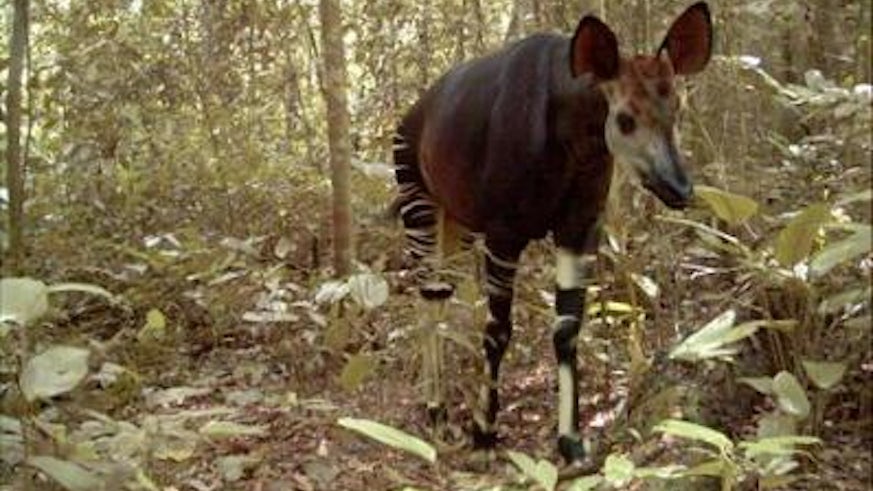Near-extinct forest giraffe shows resilience in war zone
10 Gorffennaf 2014

A pioneering genetic study of the endangered Congolese Okapi has for the first time unravelled the mystery behind its evolutionary origins and genetic structure. The new information will prove indispensable for future conservation management of the species and, ultimately, its survival.
In the past 20 years the wild okapi's numbers have halved. Prior to the study, little was known about the enigmatic animal, endemic to the forests of Central Africa. Ongoing threat from armed conflict, habitat fragmentation, human encroachment and poaching have in the past year rendered the species endangered, according to a 2013 assessment carried out for the IUCN Red List of Threatened Species.
Now, using genetic techniques similar to those employed by crime scene forensics, scientists from Cardiff and the Zoological Society of London (ZSL) have been able to piece together a better understanding of the species, bringing new hope for the Okapi. Findings were drawn from the analysis of Okapi faeces collected from the rainforest, skin samples from museums, clippings of dried skin and artefacts found in villages across its range in central and north-eastern Democratic Republic of Congo (DRC).
"Our research showed that Okapi are both genetically distinct and diverse – not what you might expect from an endangered animal at low numbers," said chief investigator of the study, Dr David Stanton from the School of Biosciences.
He added: "Higher genetic diversity means that the Okapi are equipped with the necessary genes capable of withstanding changes to their environment. Beyond that they are also more likely to survive to produce offspring bearing their own resilient genetic traits. Consequently, the population will continue for more generations because of the success of these individuals.
"This rich and distinct genetic variation is likely to be a result of periods of forest fragmentation and expansion in the Congo Basin in the ancient past. The data show that Okapi have survived through historic changes in climate, and therefore indicate that the species may be more resilient to future changes.
"There is a concern however, that much of this genetic diversity will be lost in the near future, due to rapidly declining populations in the wild making efforts to conserve the species, facilitated by the IUCN Species Survival Commission's Giraffe and Okapi Specialist Group, critical."
Only known to the Western world since 1901, the elusive Okapi is nearly impossible to observe in the wild because of its shy nature and the remoteness of the rainforests it inhabits; a trait that has helped it avoid getting caught in the cross-fire of Congo's long-running civil conflict.
The latest research into the Okapi provides an important contribution to a range-wide Okapi conservation project run in conjunction with ICCN, the Congolese conservation agency, and provides a unique perspective to better understand the diversity of wildlife in the forests of Central Africa, including information on how these forests are likely to have changed throughout ancient history. The information can also be used to help conserve other animals in the Congo Basin; an area for which very little is known and where funding for conservation work is extremely limited.
Dr Noëlle Kümpel, co-chair of the IUCN SSC Giraffe and Okapi Specialist Group and ZSL collaborator on the research, said: "The IUCN Red List assessment we carried out last year highlighted that the okapi is faring worse than we previously thought and is now 'endangered'. It's therefore critical that we step up conservation efforts across its range, and in particular ensure the integrity and security of the protected areas where okapi are found – which includes flagship World Heritage Sites like Virunga National Park and the Okapi Wildlife Reserve."
The Democratic Republic of Congo is the most bio-diverse country in Africa and its basin acts as the world's second lung, counterpart to the rapidly dwindling Amazon. It is home to other endangered species such as the Bonobo and the Congo Peafowl.
Funded by the Natural Environment Research Council, the project was conducted in collaboration with the Zoological Society of London under a NERC CASE studentship.